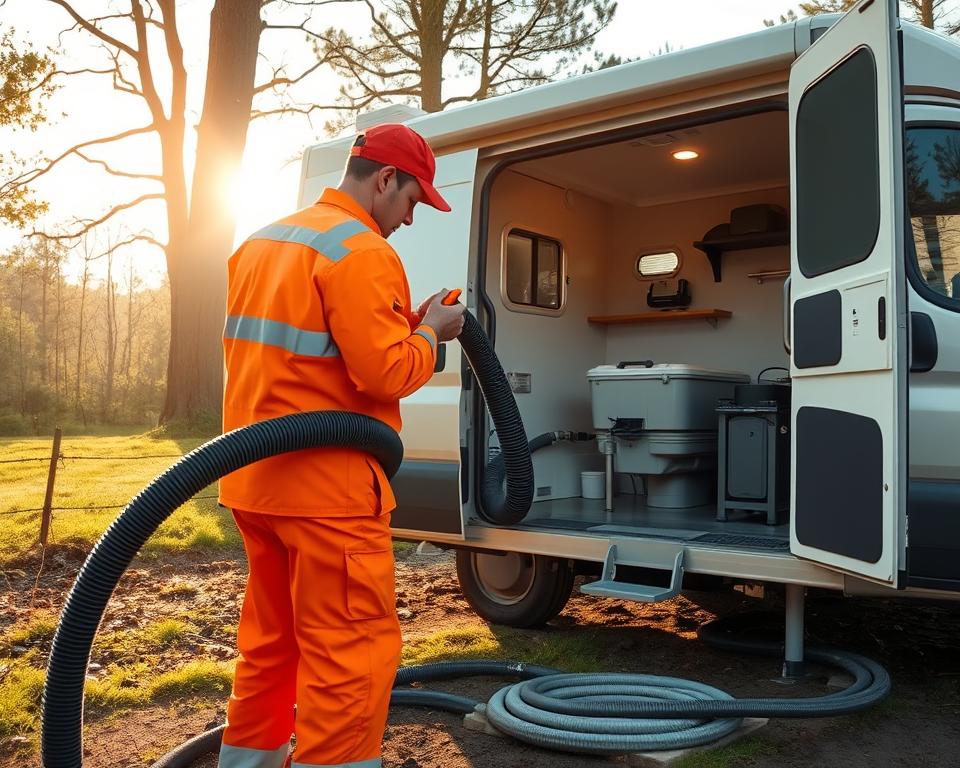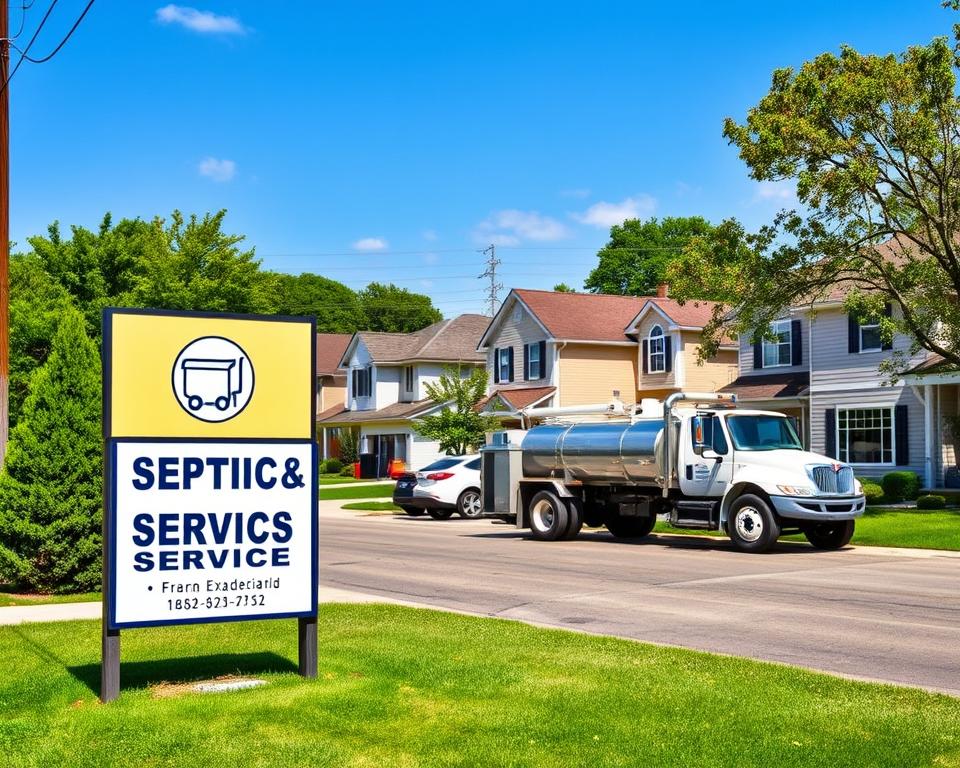Septic Air Pump: Essential Guide for Householders
Have you ever wondered what powers your air-treated Septic system’s effectiveness? The Septic air pump is the often-overlooked champion vital for your system. Through this guide, property owners will acquire useful insight on the air Pump’s purpose. It’s critical for a robust, effective Septic system.
Understanding the importance of a Septic tank air Pump can improve your Septic system’s operation using black water pumping service. It also safeguards your real-estate worth and surrounding ecosystem. Our handbook will highlight All in Sanitation, a trusted Septic industry authority. They’re prepared to serve your Septic aerator Pump requests.
Critical Findings
- The Septic air Pump is crucial for aerobic Septic systems.
- Properly caring for your Septic system air Pump can enhance overall system efficiency.
- Regular checks extend the service life of your Septic tank air Pump.
- Selecting the best-fit Septic aerator Pump is necessary for optimal operation.
- All in Sanitation offers dedicated services for Septic air Pump support.
Breaking Down Aerobic Septic Units
Aerobic Septic systems offer a superior waste treatment alternative by utilizing oxygen. This system consists of aerobic bacteria thriving in well-oxygenated environments. These bacteria are more efficient in breaking down organic matter. With the help of Septic aerator Pumps, these systems deliver a steady oxygen supply, enhancing the waste decomposition process.
These systems stand out in reducing sludge buildup, owing to the activity of aerobic bacteria. This reduction in solid waste means fewer service calls and Pumping is required. Additionally, they efficiently treat wastewater, producing little to no smell. This yields a improved environment for homeowners and the community overall.
To confirm these systems run smoothly, it’s essential to know the key Septic system components. These include the Septic tank, oxygenation chamber, and effluent Pump. Each component has a crucial role, especially the air Pump. It drives oxygen into the tank, essential for the aerobic bacteria’s activity.
Role of the Septic Air Pump
The Septic air Pump is crucial in the running of aerobic Septic systems. It serves as the system’s “air provider,” providing the vital oxygen mandatory. This oxygen helps aerobic bacteria to operate efficiently and break down waste quickly. If the Pump malfunctions, the system’s efficiency decreases, bringing about sludge increase and possible odors.
Such issues can hamper Septic system operations and lead to environmental hazards. By realizing how vital the Septic air Pump is, homeowners can move early. They can keep its best function through consistent upkeep. This avoids failures, reduces costly repairs, and maintains the aerobic system’s integrity.
Top Advantages of Using a Septic Air Pump
Utilizing a Septic air Pump notably enhances the effectiveness of Septic systems. Septic air Pumps are crucial as they speed up the processing of waste. This is done by oxygenating the treatment process, stimulating aerobic bacteria growth. These bacteria are necessary for proper waste treatment.
They’re also important in reducing foul smells. Due to more active aerobic processes, waste is treated faster, thus cutting down odors. This provides a fresher environment for homeowners.
Another significant benefit is the reduction in sludge collection. Consequently, tanks require less frequent Pumping, saving both money and time. Greater processing not only lowers bills but also extends the lifespan of the drain field.
Looking after these Pumps diligently means reduced repair costs and complying with regulatory standards. Thus, the advantages of Septic air Pumps are not only for homeowners. They also support environmental health by optimizing waste management practices.
| Benefit | Description |
|---|---|
| Fast Waste Breakdown | Enhanced aerobic activity accelerates the decomposition process. |
| Minimized Odor Emissions | Superior treatment efficacy produces fewer odors. |
| Reduced Sludge Buildup | Fewer Pumping and maintenance are necessary. |
| Extended Drain Field Life | Better treatment ensures a healthier drain field. |
| Cost Savings | Lower chance of repairs and regulatory compliance cost. |

Selecting the Best Septic Air Pump
Opting for the right Septic air Pump is vital for an efficient aerobic system. Homeowners ought to review various factors for the ideal match. The dimensions of the tank and the airflow requirements play a crucial role the Pump’s effectiveness.
To select well, it’s essential to be aware of the air Pumps available. There are mainly two types: linear diaphragm Pumps and rotary vane Pumps. Each offers particular pluses, which should be paired with your home’s unique requirements and operational profile.
Energy efficiency also is a factor. Choosing a Pump that lowers energy use while providing the needed airflow can result in lower utility bills. Assistance from All in Sanitation specialists can be very helpful. They make certain the Pump you choose suits your system’s requirements seamlessly.
Major Kinds of Septic Air Pumps
Homeowners can select wisely by knowing the distinct Septic air Pumps available. There are mainly two types: diaphragm Pumps and rotary vane Pumps. Each has its specific functions and benefits.
Diaphragm Pumps, valued for their low-noise operation, are popular for residential Septic systems. They provide energy efficiency while delivering reliable air delivery. Their constant performance suits smaller systems, preferred by many homeowners.
Rotary vane Pumps, however, are better suited for bigger or commercial systems. These Pumps offer increased power, needed for handling bigger loads. Their robust build allows efficient operation in broad Septic systems.
| Type of Pump | Best Use | Advantages |
|---|---|---|
| Diaphragm Pumps | Residential Systems | Quiet operation, energy-efficient, reliable air flow |
| Rotary Vane Pumps | Larger or Commercial Systems | Powerful performance, high capacity, durable construction |
Knowing the differences in Septic air Pumps is key for upgrades or replacements. Each Pump type brings distinct traits to address various needs. This provides peak performance for any system.
Indicators You Require a Septic Air Pump Replacement
Homeowners must be alert to Pump failure signs in their Septic systems. Some indicators show the need for a Septic air Pump replacement. These help maintain smooth operation. Identifying these promptly prevents major issues.
Signs of potential problems include:
- Unusual noises from the Pump, like scraping or vibrating, might signal internal damage.
- A clear lack of air output indicates the Pump isn’t operating efficiently, harming efficiency.
- Ongoing electrical problems, such as circuit trips or voltage drops, could point to overloading.
- Visible damage on the Pump unit, with fractures or leaks, calls for quick action.
- Foul odors in the yard often signal a compromised Pump, meaning ineffective effluent aeration.
Spotting these signs early stops pricey restoration or total system failure. Scheduling consistent assessments helps identify these issues. It also confirms if you require a new Septic air Pump.
Care Guidelines for Your Septic Air Pump
For an well-running Septic air Pump, routine upkeep is essential. This ensures that your system functions properly. Homeowners can employ several simple care strategies for best results.
Bi-annually, perform a thorough inspection for wear or damage. It is also necessary to replace the filters as indicated. This stops clogs that could reduce efficiency.
The Pump should be placed on a firm base to minimize vibrations, which could harm it over time. A protective cover is vital too. It guards against debris and water, keeping the Pump’s functionality.
Proper maintenance can greatly lengthen the life of your Pump. In turn, this benefits the Septic system’s performance in general.
| Maintenance Task | Frequency | Benefits |
|---|---|---|
| Inspect Pump for damage | Every 6 months | Catches problems quickly |
| Replace filters | As needed | Enhances operation |
| Check surface stability | Annually | Protects components |
| Clear debris around Pump | Monthly | Prevents clogs |
Installing Your Septic Air Pump
Proper installation of your Septic air Pump is critical for its efficient operation. To start, select a reliable, moisture-free area for placement. The chosen spot should securely bear the Pump’s weight without issue.
To successfully install your Pump on your own, heed the following guidelines:
- Assemble all necessary items, including the Pump, a power source, and hose fittings.
- Consult the manufacturer’s guidelines before kicking off your installation.
- Make sure every connection is proper to eliminate air leaks that hurt performance.
- After assembly, perform a test to verify the system works as intended.
If the installation process looks challenging, call All in Sanitation. Their professionals can avoid common errors, making sure your setup adheres to mandatory safety requirements.
Advantages of Using All in Sanitation for Your Septic Air Pump Needs
When selecting a Septic service provider, the choice is crucial. All in Sanitation separates itself by providing dependable Septic air Pumps. They satisfy different homeowner requirements with a extensive selection of top-tier products. This ensures customers secure an exact match for their Septic systems.
What really sets apart All in Sanitation is not solely their extensive product lineup. Their dedication to excellent customer service is just as important. Homeowners benefit from professional guidance, steering them toward trusted Septic solutions. This teamwork is key to adapt each solution to satisfy specific needs.
All in Sanitation also emphasizes aftercare to secure lasting satisfaction. Their commitment goes beyond the initial sale. They provide ongoing support to maintain Septic systems running smoothly for the long haul.
Expense Overview for Septic Air Pumps
Appreciating the costs connected with Septic air Pumps is important for homeowners with aerobic Septic systems. At first, one faces the price tag, which includes the Pump and associated accessories. Installation expenses vary, depending on the system’s complexity and any changes required.
Ongoing upkeep forms an additional cost layer. Consistent assessments can fend off bigger issues, in the long run yielding savings. Homeowners should set aside funds for Septic maintenance to retain the Pump’s effectiveness and durability. Such planning helps dodge expensive repairs later on, showing the benefit of proactive maintenance.
| Cost Component | Average Cost Range |
|---|---|
| Septic Air Pump | $500 – $1,200 |
| Installation | $300 – $800 |
| Annual Maintenance | $150 – $400 |
| Potential Repair Costs | $1,000 – $5,000 |
Breaking down Septic air Pump expenses into specific parts aids homeowners in budgeting. This detailed approach provides the system’s smooth operation and their peace of mind.
In Closing
For homeowners with aerobic Septic systems, looking after Septic setups is essential. The suitable Septic air Pump boosts waste processing and lengthens your system’s life. Scheduling routine maintenance and swiftly handling issues sidesteps costly fixes and disruptions.
Selecting a Septic air Pump warrants careful thought. This guide outlined how to decide intelligently about installation and replacement. With All in Sanitation’s help, you can handle your Septic systems’ complexities assuredly.
Taking care of your Septic air Pump promotes your system’s performance and life span. It ensures a trouble-free and optimal operation over time. Bear in mind, your home’s wastewater management is strongly influenced by regular attention.


